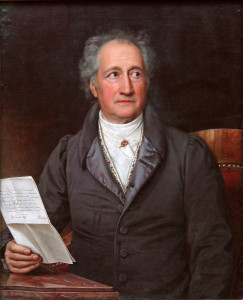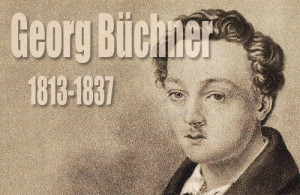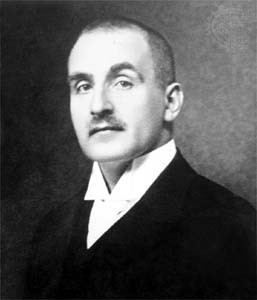The Influence of J.M.R. Lenz’s The Soldiers on Brecht’s Mother Courage and Her Children
[This is the second part of a series that considers the role of Lenz in shaping modern drama.]
Reception of the dramatic oeuvre of J. M. R. Lenz has been mixed, more often dismissive or negative than positive for more than two hundred years. Lenz, as a creative artist who parodied Enlightenment society with instinctual playfulness, posed problems for most pre-modern critics, who, as devotees of reason and descendents of Enlightenment thought themselves, leaned toward humorless, overly literal interpretations of his aesthetic intentions. The irrational aspect of the creative process, so important to all makers of art, in Lenz’s work has been trivialized as a sign of his pathology, his inability to repress tokens of his madness. Most damaging of those who perpetuated this trivialization was Goethe who, long after Lenz’s removal from Weimar, remained guarded over the dangers his former friend’s behavior posed to his own long-term reputation. Goethe’s attachment to classicism solidified Lenz’s poor image for decades, as the great man ignored his productivity in Strasbourg and cast him as “whimsical” and ”like a sick child,” someone “whose days were made up of mere nothings, to which he was able to give a meaning by his activity.”26 Since Goethe first applied it, this word “whimsical” has been used by almost every critic and historian who has written about Lenz as a code word for insane. Roy Pascal states that Goethe’s treatment of Lenz in his autobiography Poetry and Truth is “a rare instance of personal injustice.”27
More prescient is what Goethe has to say about Lenz in this passage:
His talent came from a real depth, from inexhaustible creative power, in which tenderness, versatility, and subtlety rivaled each other, but with all its beauty it was sickly at every point, and it is just these talents which are the most difficult to form a judgment.28
Leidner and Wurst’s book-length study Unpopular Virtues: The Critical Reception of J.M.R. Lenz documents this difficulty of coming to a critical consensus about Lenz and his “sickly beauty” from the 1770s to the close of the twentieth century. The authors point out that Lenz’s unwillingness to flatter audiences by depicting “weak heroes, weak families, and communities out of order” prejudiced reception against him in his time and beyond. “The critical reception of his work is Germany’s abiding inability to turn away from the pleasures of a fictive collective personality.”29
Lenz’s first play The Tutor was published anonymously in 1774 by Christian Friedrich Weygand (1743-1806), who had established himself as the most important publisher of the Sturm und Drang by printing Goethe’s The Sorrows of Young Werther. Lenz’s play was well reviewed for its bold realism and the author’s attempt to create a German drama distinct from French neoclassicism. His next two plays, The New Menoza and The Soldiers, were setbacks in his critical reception. Though neither contained anything as graphically disturbing as the castration scene in The Tutor, by the mid 1770s the Sturm und Drang movement had begun to question its own extravagance. Peers and critics who had applauded The Tutor had their doubts about The New Menoza and its spoofing of Enlightenment values. The Soldiers, with its pessimism and barracks-style language, met even greater disfavor. Lenz was a social realist who refused to oblige readers wanting flattering reflections of themselves, and he had begun to alienate the public with his middle class anti-heroes and brutal honesty.
At the turn of the century Lenz’s reception didn’t improve, largely because Romanticism, like Weimar Classicism, avoided the social conditions of its day. Writers such as Clemens Brentano glorified Lenz as a melancholy outsider and misunderstood poet, but this eagerness to sympathize with his personality clouded the Romantic’s understanding of Lenz as a social commentator.
Georg Friedrich Dumpf (1777-1849), a little known scholar and Livonian medical doctor, made the nineteenth century’s first major push toward a Lenz biography. Dumpf gathered critical information regarding his life by writing to his family, his friends at Königsberg, former Stürm-und-Dränger Klinger in St. Petersburg, and even visiting Karamsin in Moscow. In 1820 he wrote to Ludwig Tieck (1773-1853) proposing an anthology of Lenz’s work. Eight years later, Tieck, making use of materials that Dumpf had gathered, put together a three-volume edition, an important event in Lenz scholarship. Not the admirer of Lenz that Dumpf was, Tieck had agreed to have this tribute published due to his fascination with Goethe. He believed that exposure to Lenz’s writing would shed new light, through comparison, on Goethe’s genius. The most important effect of this edition is that through it Georg Büchner came to know Lenz’s work.
Inspired by Lenz’s The Land Preacher (1776), Büchner wrote his rebellious pamphlet The Hessian Courier (1834). Later under police interrogation, Büchner was forced to deny authorship of this pamphlet. He then turned to the stage as a means of activism against the reactionary caste system of post-Napoleonic Europe. Lenz the social realist was a natural model for Büchner. His world-acclaimed fragment Woyzeck would have been “unthinkable,” as Helga Madland and Alan Leidner have written, without Lenz’s The Soldiers.30 Büchner, like later writers in the Lenz tradition, demonstrated his affinity for his Sturm-und-Drang predecessor, not by praising him in theoretical writing, but by emulating his dramatic practice.
For much of the nineteenth century Lenz’s biographical or historicized reputation as mad poet and doomed lover of Fredericke Brion overshadowed interest in his work. Toward the end of the nineteenth century the dramatists of Naturalism saw an ally in Lenz for his realistic portrayal of everyday life and his combative stance against age-old traditions of the theatre. Karl Bleibtreu (1859-1928) regarded Lenz as “unsurpassed in unmediated truth, the truth of life and character.”31 Max Halbe (1865-1944) praised Lenz for his opposition to the timeless realm of Weimar Classicism. 32
During the twentieth century Lenz’s work was repellent to both the extreme right, as voiced by Adolf Bartels in what would be a preview of the attitude of National Socialism of the 1930s, and the extreme left, as voiced by the utopian Marxist George Lukaćs in the 1950s. Bartels referred to Lenz’s plays as “monstrosities whose attractions lie only in the characterizations, and in individual scenes.”33 Lukaćs criticized Lenz’s plays for their pessimism and embraced the heroic idealism of Goethe’s classicism. Ideological movements such as fascism and communism depended on an idealized notion of the German public evolving from the glorious Volk of the past into a perfect future society. To believers in such totalizing visions, Lenz was not welcome.
Brecht’s adaptation of The Tutor in 1950 instigated a postwar renewal of interest in Lenz. Heiner Müller, the East German playwright and Brecht follower, spoke for many in resisting Lukaćs and supporting a turn away from Weimar Classicism. Müller regretted the neutralization of Sturm und Drang by Weimar Classicism and his view mirrored Lenz’s discomfort with Goethe at the ducal court. Müller described Weimar Classicism as “Literature of a vanquished class, form as adjustment, culture as a set of formal manners for intercourse with the ruling power, and as vehicle for false consciousness.”34 In 1968, in the commentary that appeared with the operatic adaptation of The Soldiers, Heiner Kipphardt wrote of the play as “one of the key works in the history of the German theatre. Its influence can be traced through Büchner, Grabbe, Wedekind, Brecht, Horvath, up to the contemporary German Drama.”35
As the 200th year anniversary of Lenz’s death neared in 1992, Lenz became a subject of lively scholarly interest. Bicentennial celebrations of Lenz’s death inspired a wealth of new criticism and international symposiums in Oklahoma (1991), Hamburg (1992) and Birmingham, England (1993).
Adaptations/ Historic Productions of The Soldiers
With one exception, Lenz’s nine original dramas were not staged in his lifetime. The exception is a version of The Tutor rewritten by the influential actor/director Ludwig Schröder and staged in Hamburg in 1778 (not seen by its author). For this adaptation Schröder, who made his name staging Sturm und Drang plays, cut fourteen roles, drastically reduced the thirty-five scene changes, and simplified the plot to focus on love lost and then regained.36 During the whole nineteenth century only The Soldiers was staged. The rest of the nine plays were not performed until the twentieth century. Michael Patterson comments that The Soldiers is that rare example of a play written for a stage that did not yet exist.37 The first production didn’t materialize until 1863 when an unfaithful and prudish adaptation by Eduard von Bauernfeld, in which only the first two acts of Lenz’s play are recognizable, was performed at the Burgtheater in Vienna. To meet the demands of a theater public that insisted on uplifting entertainment, the officer baron (renamed Könneritz), doesn’t abandon the protagonist Marie Wesener. Instead a kingly decree allows him to resign his military post (therefore exempting him from the law against soldiers marrying) and marry the play’s heroine.38 A resounding failure, Bauernfeld’s rewrite ran for only three performances. No other production of Lenz would appear for almost fifty years.
At the beginning of the twentieth century, Frank Wedekind, the author of Spring Awakening, inspired a pro-Lenz sentiment in Munich that led to the Künstlertheater staging of the Artur Kutscher adaptation of The Soldiers in 1911. This adaptation, aided by a theater climate fomented by the Naturalists and Expressionists, was much truer to the text than Bauernfeld’s version. Kutscher cut only four scenes, including the controversial final scene. He combined the remaining thirty-one scenes into sixteen for the sake of continuity, but generally recognized the non-linear or epic quality of the play’s structure. The single but significant Künstlertheater performance attracted the attention of Max Reinhardt. This resulted in Reinhardt’s 1916 production at the Deutsches Theater in Berlin, where the play was performed nearly in its entirety with an enormous revolving stage.39
The twentieth century saw three operatic adaptations of The Soldiers. Soldaten (1930) by Manfred Gurlitt is obscure. His Wozzeck (1926) marked the zenith of his musical career yet was overshadowed by Alan Berg’s operatic version of Büchner’s great play. Gurlitt joined the Nazi party in 1933 but was ejected in 1937 and fled to Japan the same year Brecht was writing Mother Courage. Heiner Kipphardt’s opera was performed in Dusseldorf, in 1968. The most notable of the three is Bernd Alois Zimmerman’s, described as an “opera in four acts after the homonymous drama by Jakob Michael Lenz.”40 This adaptation of The Soldiers was first performed in Cologne in 1965 and most recently in New York City in the summer of 2008.
This recent Lincoln Center Festival staging of Zimmerman’s twelve-tone libretto in the Drill Hall of the Park Avenue Armory was an astonishing technical feat with a 250-foot stage that bisected the hall and ended in a “T.” The audience glided alongside the stage on a pair of 500-seat bleachers on railroad tracks at a top speed of 7.5 inches per second. In this way Zimmerman’s opera was a moving experience. My reaction to the fifth and closing night performance concurs with that of reviewer Heidi Waleson, who wrote that despite its high tech and expensive production values the work seemed dated, “trapped in a mid-century time warp” and that it came off as “an angry, rather one dimensional rant against war and class snobbery.”41 Critic Alex Ross said the experience was like taking a hot air balloon over a volcanic eruption; Ross praised the extravagance of the spectacle and the power of the orchestra while condemning the monotonous vocal writing for the singers.42 In my view, Zimmerman was more faithful to Lenz’s theoretical essay “Notes on the Theatre”—from which he drew inspiration, seeing parallels to his “spherical construction of time”43—than to the play, whose thematic complexity he slighted. Most disappointing to an admirer of Lenz’s text was that the subtle ironies of the gestic language were cut. For example, in the third scene of the opera Wessener refuses to allow the officer Desportes to take his daughter to the theatre and Desportes exits. In the play instead of exiting, Desportes picks up on the visual and linguistic clues of Wessener’s divided nature and sends the jeweler to fetch brooches so he can arrange a secret rendezvous with the daughter.
New English translations of The Soldiers, The New Menoza, and The Tutor were produced at the Edinburgh International Festival in 1993. Besides earlier, scaled-down productions of Zimmerman’s opera in New York and Boston, as far as I can ascertain, there have been no other productions of Lenz’s plays in the United States. An indication of this comes from Horst Richardson’s survey of plays from German-speaking countries over a fifteen year period, 1973-1988; the survey includes only plays produced on American university stages, where the work of lesser known German playwrights were more likely to appear than in the commercial theatre. Brecht led the list with 318 productions. There were twenty-four different Brecht plays accounted for, almost half of all German plays compiled. Georg Büchner and Frank Wedekind were fourth and fifth, with thirty-seven and thirty-four productions, behind Swiss playwrights Friedrich Dürrenmat and Max Frisch. Richardson’s survey, which includes thirty-five German authors who had at least one production, attests to the overwhelming popularity of Brecht. Lenz’s name is absent.44
Endnotes [Continued from Part 1 of Taking Courage from the Sturm und Drang]
26. Goethe, Poetry and Truth, 530.
27. Pascal, The German Sturm und Drang, 27.
28. Goethe, Poetry and Truth, 530.
29. Leidner and Wurst, Unpopular Virtues, 8-9.
30. Alan C. Leidner and Helga S. Madland, eds., from the “Introduction” in Space to Act: The Theater of J. M. R. Lenz, (Columbia, South Carolina: Camden House, 1993), xvi.
31. Unpopular Virtues, 45.
32. Unpopular Virtues, 45.
33. Unpopular Virtues, 59.
34. Heiner Müller “Fatzer +/- Keuner,” Essays on German Theatre: Lessing, Brecht, Dürrenmatt, and others, The German Library Volume 83, ed. Margaret Herzfeld-Sander (New York: The Continuum Publishing Company, 1985), 338.
35. John Osborne, “Anti-Aristotelian Drama from Lenz to Wedekind,” In The German Theatre, ed. Ronald Hayman (London: Oswald Wolff, Ltd., 1975), 87.
36. Edward P. Harris, “Lenz on Stage: Schröder’s Adaptation of Der Hofmeister,” In Space to Act: The Theater of J. M. R. Lenz (Columbia, South Carolina: Camden House, 1993), 138-139.
37. Michael Patterson, “The Theater Practice of the Sturm und Drang,” In Literature of the Sturm und Drang ed. David Hill (Rochester, New York: Camden House, 1973), 141.
38. Osborne, Heroism,153.
39. Osborne, Heroism, 155-157.
40. Bernd Alois Zimmerman, The Soldiers: Opera in four acts after the homonymous drama by Jacob Michael Reinhold Lenz, trans. John Patrick Thomas and W. Richard Rieves (Mainz, Germany: Wergo, a Division of Schott Music & Media, 2007).
41. Heidi Waleson, “Singers Muster in the Drill Hall,” (The Wall Street Journal, July 10, 2008).
42. Alex Ross, “Infernal Opera: Zimmerman’s Die Soldaten at the Park Avenue Armory” (The New Yorker, July 21, 2008), 88-89.
43. Heinz Josef Herbort, “Bernd Alois Zimmerman: Die Soldaten” trans. Thomas and Rieves, (see n. 40, essay for the Wergo LP released 1968), 53.
44. Horst Richardson, “Plays from German-Speaking Countries on American University Stages 1973-1988,” Die Unterrichtspraxis/Teaching German, 23, 1 (Spring, 1990), 76-79.




Leave a Reply